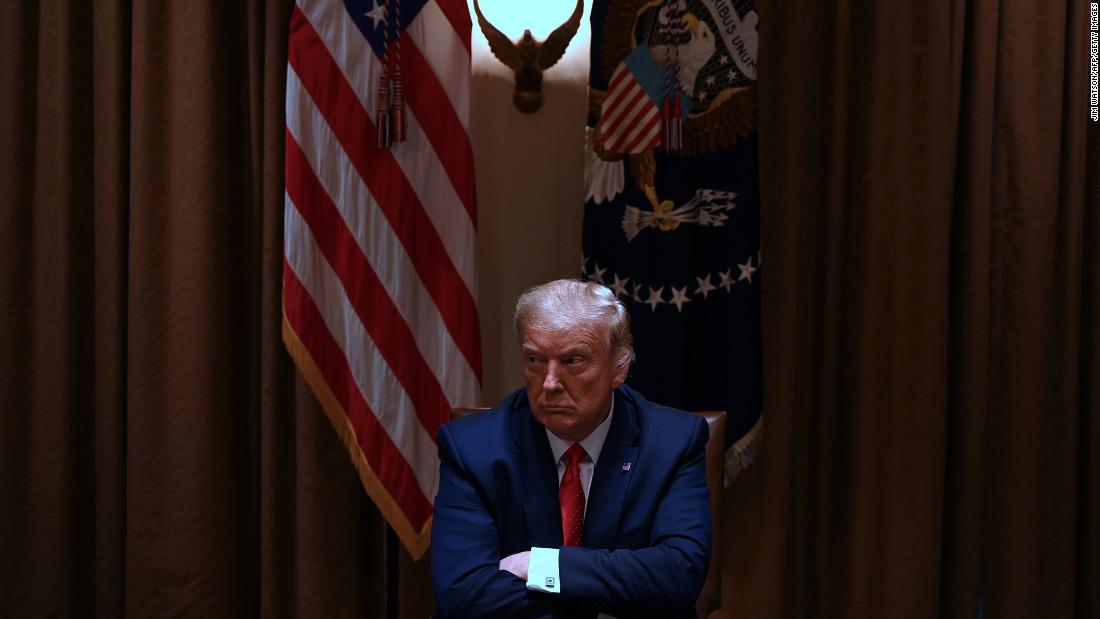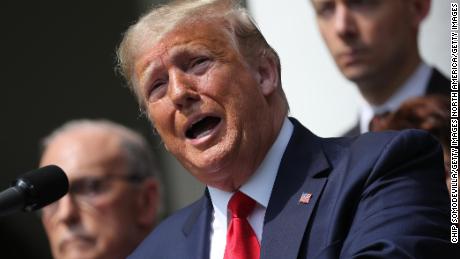Analysis: The US is diving into a dark Covid hole — and there’s no plan to get out
Delusion dominates an administration that perversely claims the United States is the world leader in beating this modern day plague. There are only contradictions, obfuscations and confusion from the federal officials who ought to be charting a national course.
The massive integrated testing and tracing effort that could highlight and isolate infection epicenters doesn’t exist. Attempts to reopen schools in a few weeks are already descending into farce amid conflicting messages from Washington.
Amid all of this, the coronavirus task force does not hold daily briefings, and when it does, they are an exercise in dodging difficult questions and self-congratulation.
It’s unimaginable that any other modern President would have handled things this way. Most would have thrown every federal government dollar, resource and expert at it. But Trump appears to believe his reelection relies on creating an alternative reality in which tens of thousands of Americans — now mostly in states where he is overwhelmingly popular — are not being infected rather than actually beating back the pandemic.
The President’s claim that 99% of Covid cases are harmless is not only false, it’s an insult to the death and sickness left in the wake of the virus — and the lifelong conditions it may have spawned among survivors.
US leads the world in cases, deaths
Staggeringly, the United States — the world’s richest nation that has just over 4% of the planet’s population — has a quarter of global cases of Covid-19 and nearly a quarter of the deaths. Intensive care units are filling up across southern and western states. It took the US 99 days to reach one million cases, 43 days to get to 2 million and 28 days to add another million. That’s a horrific rate of increase.
In mid-May, in what were then assumed to be the darkest days of the crisis, the US was recording around 20,000 new cases a day. Now it’s averaging around 60,000. America’s competitors in Europe and Asia and the Pacific endured their own horrors, but have largely been more successful in suppressing infection curves. They are swift to isolate outbreaks, for instance, in Melbourne, Australia, where a six-week lockdown has been imposed.
While US medical researchers and corporations are in the vanguard of efforts to find therapies and cures, the US effort to quell the virus’ deadly march represents nothing less than a political debacle that humbled the world’s most powerful nation in the eyes of its allies and those who wish it ill. The massive disconnects between federal and state and local officials are making President George W. Bush’s Hurricane Katrina disaster look like a trifle.
In such circumstances, humility might be expected from the Oval Office, where the buck for such failures used to stop. Instead, Trump is not only saluting himself for a fantastic success, he’s recommitting to the counter-scientific strategies of opening the country at all costs that seeded the latest disaster. His mind, as always, is fixated on Election Day.
“We did it right,” Trump declared in the White House Rose Garden on Thursday, adding a litany of false claims about testing, death rates and overly optimistic predictions of effective treatments for Covid-19 and the possibility of a vaccine “very, very, soon.” Trump’s top aides bristle at any criticism, reflecting how lionizing a President who has navigated states of denial, ignorance, indifference and negligence about the virus is more important than looking reality in the eye.
“Of course the US remains the world leader in the pandemic,” Secretary of State Mike Pompeo insisted on Wednesday.
Fauci begs to differ.
“As a country, when you compare us to other countries, I don’t think you can say we’re doing great. I mean, we’re just not,” the government’s top infectious disease specialist told FiveThirtyEight’s podcast on Covid-19 on Thursday.
No sign the US will do what works
In parts of the country — in New York, New Jersey and Massachusetts for instance — there is some hope that after proper mitigation efforts and a tight hand on the reopening tap the virus can be kept at low levels, at least until a feared winter outbreak. Republican governors in Ohio and Maryland who heeded epidemiology suppressed vicious epidemics. In states and cities where trusted leaders give simple, honest messages, progress is possible.
But the desperate developments exacerbated by the leadership vacuum are shredding hopes that Americans can get back to school, college, work and sports arenas in the coming months — absent some stunning development in therapeutics or vaccines.
It is no secret what has worked inside the US and elsewhere in quelling the virus. Early shutdowns, social distancing, the use of masks and prudent opening plans have helped lower new infections to manageable levels from New York City to Italy. Aggressive testing and tracing operations have kept a lid on the pandemic in South Korea and allowed officials in Singapore and Germany to quickly snuff out hotspots.
There is no sign that such competence will soon arrive in the US. The administration, which has offloaded responsibility for fighting the virus to states, doesn’t appear to have the desire or capacity to build any such system.
Only firm national leadership can plot a route out of the crisis and help states currently heading into the hot zone join those who have suppressed the virus, said Dr. Peter Hotez, dean of tropical medicine at Baylor School of Medicine.
“We just don’t have the leadership to make that happen,” Hotez told CNN’s Wolf Blitzer on “The Situation Room.”
Trump’s constant undermining of advisers has also exacerbated a situation in which people either don’t take the virus seriously or indulge fatigue with lockdowns by letting their guards down.
“I think just think sometimes it really sends the wrong message and it confuses the public,” Maryland’s Republican Gov. Larry Hogan told CNN’s “New Day” on Thursday.
“If everybody in the administration is saying it’s not safe and we need to do … these things and the President says to ignore all of that advice and do what he says, I just think it’s a mistake that the President’s been making.”
School opening debacle
The CDC guidelines offer a comprehensive plan for social distancing and barriers in classrooms, staggered learning, smaller class sizes and prohibitions on students mixing outside the classroom. A brief glance at the guidelines explains Trump’s anger. There is no way that in hard-hit cities that are closing bars, limiting big gatherings and other events, it will be feasible for schools to open in even this diminished fashion. The fact that the White House is only now concentrating on the issue — weeks before classes are supposed to resume — is typical of its procrastination on key issues in the pandemic.
“I would say that when we talk about the fall, that seems like a long time,” Trump told Nexstar Media this week while failing to lay out any workable plans for school openings. But he’s still insisting that if kids in Denmark, Norway and Germany can go back to school, then America’s children must too — while ignoring the fact that those countries are not stuck in the middle of their raging peaks of the pandemic.
Administration officials repeatedly point out that children are less susceptible to Covid-19 complications than their elders. They rightly point out the severe emotional, educational and psychological impact on children who have been out of school for months. It’s also true that school shutdowns and consequent childcare issues for parents disproportionately affect lower income families.
But officials never give a straight answer to the question of what happens to teachers who, as adults, are at a higher risk of getting really sick from the virus. There are also no answers for what parents should do to stop their kids coming home from school and infecting them and older relatives. Such omissions are typical in an administration that prefers to avoid thorny questions that might temper its political aspirations.
![]()




